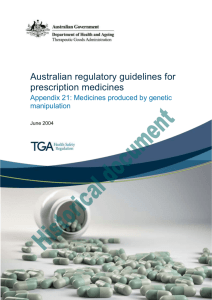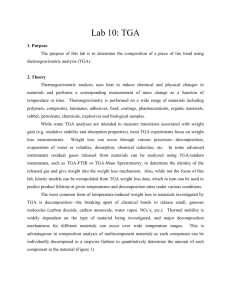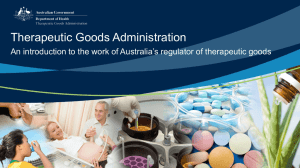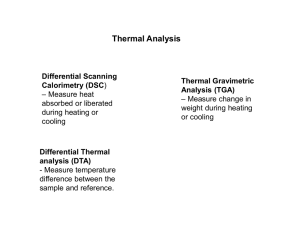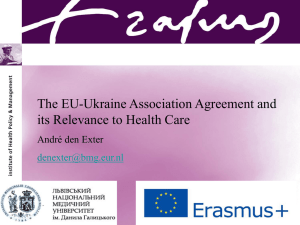BioPharma Strategic Regulatory Services
advertisement
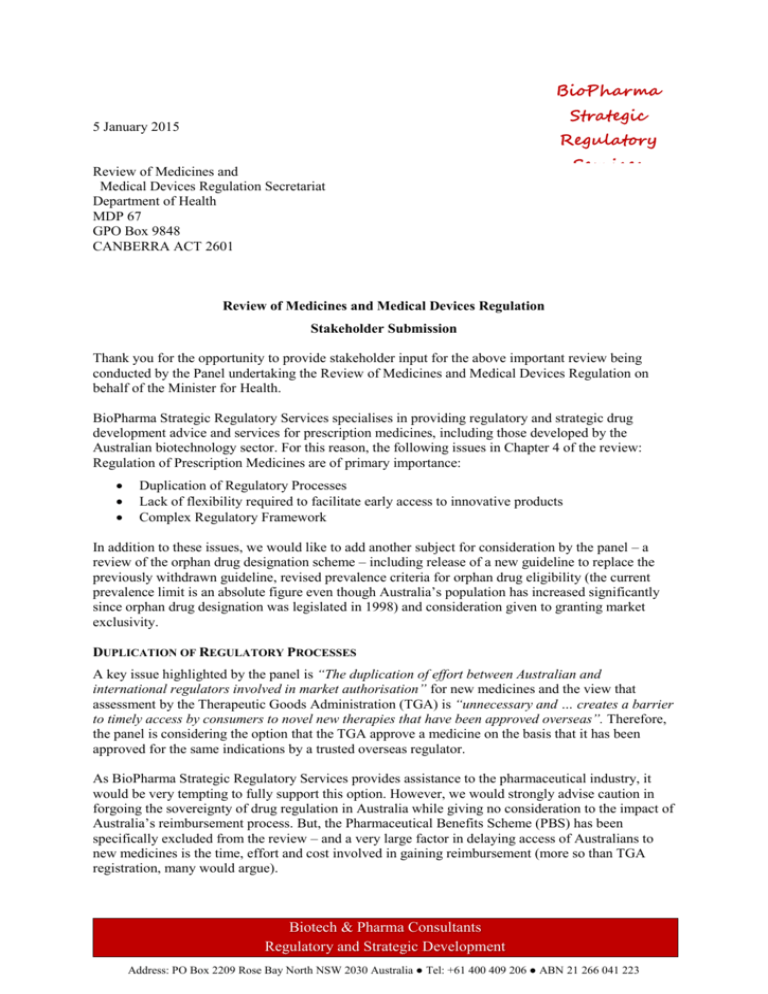
BioPharma Strategic 5 January 2015 Regulatory Review of Medicines and Medical Devices Regulation Secretariat Department of Health MDP 67 GPO Box 9848 CANBERRA ACT 2601 Services Review of Medicines and Medical Devices Regulation Stakeholder Submission Thank you for the opportunity to provide stakeholder input for the above important review being conducted by the Panel undertaking the Review of Medicines and Medical Devices Regulation on behalf of the Minister for Health. BioPharma Strategic Regulatory Services specialises in providing regulatory and strategic drug development advice and services for prescription medicines, including those developed by the Australian biotechnology sector. For this reason, the following issues in Chapter 4 of the review: Regulation of Prescription Medicines are of primary importance: Duplication of Regulatory Processes Lack of flexibility required to facilitate early access to innovative products Complex Regulatory Framework In addition to these issues, we would like to add another subject for consideration by the panel – a review of the orphan drug designation scheme – including release of a new guideline to replace the previously withdrawn guideline, revised prevalence criteria for orphan drug eligibility (the current prevalence limit is an absolute figure even though Australia’s population has increased significantly since orphan drug designation was legislated in 1998) and consideration given to granting market exclusivity. DUPLICATION OF REGULATORY PROCESSES A key issue highlighted by the panel is “The duplication of effort between Australian and international regulators involved in market authorisation” for new medicines and the view that assessment by the Therapeutic Goods Administration (TGA) is “unnecessary and … creates a barrier to timely access by consumers to novel new therapies that have been approved overseas”. Therefore, the panel is considering the option that the TGA approve a medicine on the basis that it has been approved for the same indications by a trusted overseas regulator. As BioPharma Strategic Regulatory Services provides assistance to the pharmaceutical industry, it would be very tempting to fully support this option. However, we would strongly advise caution in forgoing the sovereignty of drug regulation in Australia while giving no consideration to the impact of Australia’s reimbursement process. But, the Pharmaceutical Benefits Scheme (PBS) has been specifically excluded from the review – and a very large factor in delaying access of Australians to new medicines is the time, effort and cost involved in gaining reimbursement (more so than TGA registration, many would argue). Biotech & Pharma Consultants Regulatory and Strategic Development Address: PO Box 2209 Rose Bay North NSW 2030 Australia ● Tel: +61 400 409 206 ● ABN 21 266 041 223 The panel points out: “Australia’s regulation of medicines is highly regarded internationally”. In the Asia-Pacific region, many countries place great importance on TGA approval when assessing applications for new medicines – and many send representatives to Australia for training. If the TGA were to adopt the approach of approving applications on the basis of approval by another agency – with what appears to be no review – then Australia would be applying a lower level of scrutiny than many of these same countries – where some level of local assessment is conducted. As discussed by Prof John Skerritt at the recent 2014 Annual Scientific Conference of ARCS Australia1, the TGA is making great headway towards cooperation and harmonisation with major regulators – demonstrated by the number of international initiatives involving the TGA. This was a key recommendation of the Baume Report following a thorough review of the TGA in 19912 and should be allowed to continue for TGA to remain a major player in international medicine regulation rather than risking being left behind. If new medicine assessment became an exception rather than the norm, the expertise of evaluators and expert committees gained over the past 50-60 years could be lost. The panel argues “Advocates for greater use of overseas assessment reports point to the fact that very few drugs that are approved by one major regulator are subsequently rejected by another”. This is a broad-sweeping statement with no supporting evidence to justify the claim. In fact, Prof Skerritt discussed 14 such divergent decisions occurring between Europe and the US in the period 2006 – 20131. Furthermore, even if a medicine is approved by two regulators, this does not necessarily mean the approved indication is the same. The European Medicines Agency (EMA) commissioned a study investigating the subjectivity of evaluators when assessing medicine applications3. The study found: “Regulatory evaluation of medicinal products involves determining the balance between the benefits promised by the product and the attending potential harms. This process requires reviewing the clinical data submitted by the product manufacturer and determining the probability of harm and magnitude, but in doing so assessors’ belief systems and values are also engaged, giving rise to variability among assessors and contributing to divergent opinions.” In 2013, a review of the regulatory decision-making process was published under the umbrella of the World Health Organisation (WHO)4 . In addition to the observations in the above study, the authors found that “a regulator’s assessment of the data package is likely to be mediated by informal factors such as the interaction with external stakeholders (e.g. pharmaceutical companies, patients or other regulatory agencies) and influenced by socio-cultural and behavioural aspects”. The paper also discussed the significant cultural and structural differences between the EMA and FDA to help explain the differences in the regulatory decisions for some medicines. Divergent regulatory decisions between EMA and the US Food and Drug Administration (FDA) for oncology medicines were investigated in another study – based on publicly available assessment reports5. Of the total 100 indications for 42 oncology medicines approved by the two agencies, the authors found no difference in the indications in only 52 cases. In 47 cases, significant differences were observed (one case could not be assessed due to the lack of public information). In 19 cases, an indication was approved by one agency but not the other (3 not approved by EMA and 16 not approved by FDA). In the remaining 28 cases, one agency approved a more restrictive indication than the other (FDA more restrictive in 13 cases and EMA more restrictive in 15 cases). Therefore, any differences between agency decisions need to be investigated thoroughly before removing such an important safeguard protecting the wellbeing of Australians. For the TGA, each previous rejection decision for an application approved overseas – or where a more restricted indication was approved – should be independently audited and the risk-benefit determined for such medicines if approved in accordance with the rules of a new scheme. This audit would need to consider, amongst other factors, differences in clinical practice and availability of alternative treatments between Australia and the other country/countries. Page 2 Instead of TGA “rubber stamping” approval of a medicine based on another regulator’s assessment, we would think it more prudent to re-visit another recommendation presented in the Baume report2 – the introduction of the “Category 2” application (only very briefly mentioned in the current review) whereby an abbreviated evaluation would take place compared to the standard Category 1 application if the sponsor submitted evaluation reports from two overseas agencies which were on the list of acceptable agencies – leading to earlier approval. This has been a very under-utilised avenue for evaluation as most sponsors find the requirements and logistics too onerous, thereby causing delays in submission. Furthermore, the TGA’s new prescription medicines streamlined evaluation process makes no distinction between Categories 1 and 2 thereby negating any advantage for sponsors to submit Category 2 applications. We therefore recommend: TGA approval of a medicine on the basis of an assessment by a trusted overseas regulator NOT to be pursued, and instead; TGA work with stakeholders to refine the Category 2 evaluation requirements to restore reduced approval timelines and improve practicality for sponsors TGA to continue in its endeavours to be a key member of international collaborative initiatives to strive towards more efficient medicine approval. Note: Although the PBS has been excluded from the current review, some changes to the current evaluation process could allow the recently implemented parallel process to work more efficiently. For example, a major reason for delays in decisions by the Pharmaceutical Benefits Advisory Committee (PBAC) is the uncertainty around the indication – as only a clear signal of the clinical delegate’s intent is given in the delegate’s overview which is one of the last drafted TGA documents. If there was scope to change work processes, it may be possible for the delegate to recommend an “approvable” indication as part of the first round of TGA questions (as well as any major objections – which most sponsors have some difficulty in addressing within the allowed 2-week period prior to the meeting of the Committee on Prescription Medicines (ACPM)). LACK OF FLEXIBILITY REQUIRED TO FACILITATE EARLY ACCESS TO INNOVATIVE PRODUCTS Under the current inflexible requirements and timelines of the new streamlined evaluation process, there is little scope for accelerated approval for important medicines due to the reliance on the advance allocation of resources. The Prescription Medicines Registration Process (dated 9 September 2014) makes a brief reference to priority reviews, but noting there is no formal process, and only that TGA will “wherever possible, work with the relevant applicant with a view to facilitate early access to the new product”. Therefore, there is a need for a formal program to ensure Australians have faster access to important medicines which can be demonstrated to offer significant improvement in survival or quality of life for life-threatening or chronic debilitating conditions. If approval would be based on a reduced clinical dataset, then post-approval commitment to further trials should be discussed with the TGA prior to the submission. The TGA has been including postapproval commitments more and more in the conditions of approval for new medicines (particularly orphan medicines) and therefore this allowance should not be new to the clinical delegates. This would be an opportune time for consideration being given to allowing sponsors to submit new data during the evaluation – which was acceptable prior to the new streamlined evaluation process. Many overseas regulators allow submission of new data with no impact on timelines to a decision in most cases. Page 3 To allow the TGA to allocate sufficient resources to accelerate its review, it may be possible for sponsors to submit a pre-submission earlier than the current 2½ months required for major applications – if some of the documentation requirements were relaxed. Another consideration should be assistance provided for Australian biotechnology companies of which many are in the process of developing products for serious medical conditions. These companies would greatly benefit from earlier engagement with the TGA in providing feedback on their pharmaceutical development and non-clinical and clinical programs. There is further discussion on the provision of scientific advice for such companies under Complex Regulatory Framework; however, where products are developed for serious medical conditions, it would be very advantageous for the TGA to adopt a process similar to the FDA Breakthrough program whereby intensive scientific advice is provided, organisational commitment given from senior TGA managers and a rolling review of the data as it becomes available. In addition to companies receiving earlier evaluation of their data and advice on the need to conduct additional studies to address findings, this would facilitate earlier TGA approval which would assist in obtaining approval internationally. We therefore recommend: development of a formal priority review process for important medicines including allowance for post-approval commitments and submission of new data during the evaluation development of a process similar to the FDA Breakthrough program for Australian-developed important medicines COMPLEX REGULATORY FRAMEWORK Commercialisation of Australian medical research has been covered in at least three recent Commonwealth Government reviews and discussion papers, highlighting the importance of the biotechnology/pharmaceutical sector: 1. Strategic Review of Health and Medical Research, Feb 2013 (Department of Health and Ageing) 2. Boosting the commercial returns from research, Oct 2014 (Departments of Industry & Education) 3. Australian Industry Report, Dec 2014 (Office of the Chief Economist, Department of Industry) All three reports discuss the high output from Australian research and the potential for strong prospects for future commercial growth, leading to a significant contribution to the economy. There is strong backing for additional Government support mechanisms including revision of the R&D Tax Incentive, plans for a roadmap for long-term research infrastructure investment and creating stronger incentives for collaboration between researchers and industry. There is an important role TGA can play in assisting in the success of the local industry. Considered, objective scientific advice early and throughout the development of a new product is crucial to maximise approvability6. Even if a company is not necessarily aiming for marketing approval itself but rather out-licensing or partnering with a larger company, objective regulatory scientific advice could have a great impact on the value of the intellectual property by helping ensure drug development proceeds in a meaningful manner rather than the generation of “interesting” results for the researchers. Currently, we recommend our clients seek early scientific advice from the FDA which has a culture of early engagement with industry facilitated by the offer of meetings at important milestones (before approval of the first clinical trials, before initiation of the phase 3 program and before submission of the marketing application). Although meetings with the TGA can be valuable, their more informal and less structured format means the advice provided can vary widely in quality (although personal experience has been favourable). Furthermore, as the Baume Report (2) stressed the importance of TGA not requiring additional data to other agencies unless it was seen as critical to the Australian context, meetings are primarily focused on the acceptability of the completed or near-completed data package prior to submission of the marketing application rather than TGA assisting sponsors in Page 4 paving the way forward in drug development. Consequently, many TGA evaluators are not sufficiently experienced in providing such advice to assist Australian companies who are in early development – although one paper has reported on a “highly informative” series of such meetings with the TGA (in this case - tripartite meetings also involving the PBAC Secretariat)7. It would greatly assist the local industry to receive documented scientific advice from the TGA during drug development. Although many companies will still need to seek advice from the FDA (and European agencies) to ensure acceptability of the data package internationally, prior structured TGA advice would be advantageous to better prepare companies and validate their approach to drug development. It is also much more efficient and beneficial to have early and ongoing dialogue with a local agency which would potentially be more engaged with the company and its personnel than one in a foreign country. There may be the possibility be of a pilot program of joint scientific advice meetings with TGA and FDA (facilitated by teleconference or videoconference) which could be beneficial to all parties (evaluators from both regulators could appreciate the thinking and concerns of other regulators as well as the opportunity to educate inexperienced TGA evaluators). Another form of assistance local small companies which are usually cash-poor would be the introduction of TGA fee waivers. The FDA currently offers a fee waiver for the first application from small companies which meet certain criteria. A similar program could be offered by the TGA. We therefore recommend: development of a program for scientific advice to assist in drug development for Australian companies (in addition to the current pre-submission meetings) introduction of a system of waivers for TGA fees for small Australian companies I trust the panel will give due consideration to the views and recommendations in this submission. If there are any questions on any points in this submission, please do not hesitate to contact me by telephone: 0400 409 206 or by email: r.sinani@biopharmasrs.com.au. Your sincerely Ron Sinani Principal Consultant BioPharma Strategic Regulatory Services REFERENCES 1. Skerritt, J. International regulatory cooperation: more important than ever. Presented at Annual Scientific Conference of ARCS Australia, Canberra 10-11 Sep 2014. Accessed at: https://www.tga.gov.au/presentation-international-regulatory-cooperation-more-important-ever 2. Baume P, Staples P. (1991). A question of balance : report on the future of drug evaluation in Australia, commissioned for the Minister for aged, family and health services, the Hon. Peter Staples. Canberra : Australian Govt. Pub. Service Page 5 3. EMA Benefit-risk methodology project: Report on risk perception study module 24 Jan 2012; EMA/662299/2011 4. Tafuri G. (2013). Exploring the regulatory decision-making process for medicines. Conducted under the umbrella of the Utrecht-World Health Organization (WHO) Collaborating Centre for Pharmaceutical Policy and Regulation, 5. Tafuri G, Leufkens HGM, Laing R, Trotta F (2010). Therapeutic indications in oncology: Emerging features and regulatory dynamics. Eur J Cancer;46(3):471-5. 6. Regnstrom J, Koenig F (2010). Factors associated with success of market authorisation applications for pharmaceutical drugs submitted to the European Medicines Agency. Eur J Clin Pharmacol;66(1):39-48. 7. Wonder M, Backhouse ME, Hornby E (2013). Early Scientific Advice Obtained Simultaneously from Regulators and Payers: Findings from a Pilot Study in Australia. Value in Health;16:10671073. Page 6
